Unearthing Japan’s lesser-known past Researchers and students work to crack mysteries surrounding early history of Hokkaido
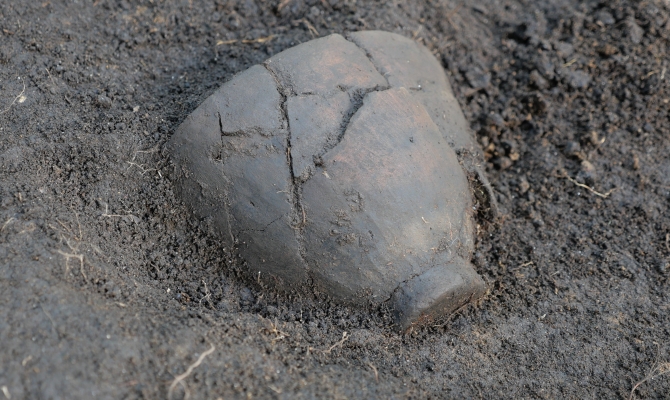
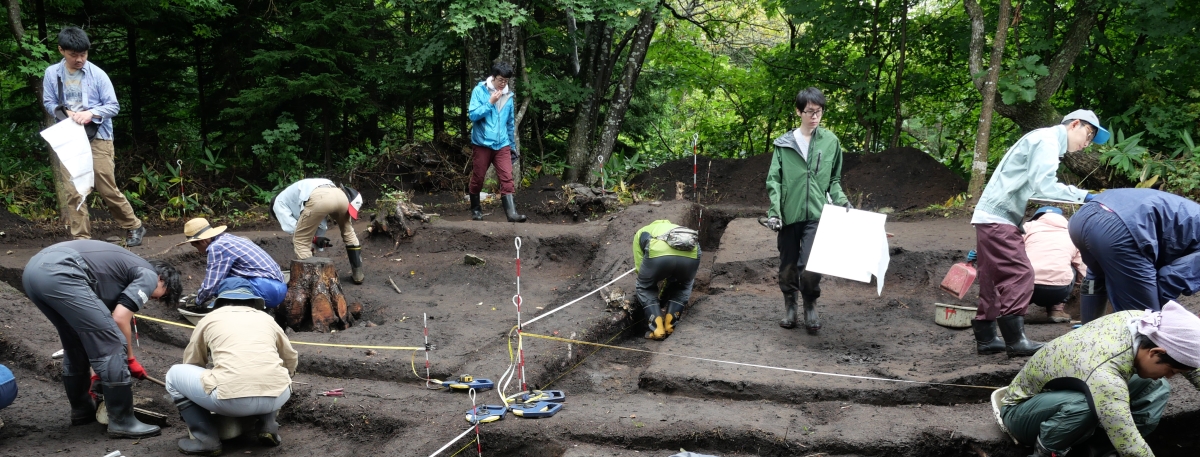
UTokyo students take part in excavation training at an archaeological site in Tokoro, northeastern Hokkaido, in August 2019.
The weather that morning was overcast, with occasional drizzle. The ground had been already muddy due to rain from the day before. For students setting off on an archaeological dig of an 11th-to-12th-century pit dwelling in the town of Tokoro, northeastern Hokkaido, the conditions on that late August day in Japan’s northernmost prefecture were far from perfect.
Still, the group comprising graduate and undergraduate students from the Department of Archaeology appeared unfazed. They parked their cars at a local golf course and took a footpath into a forest, until they arrived at the digging site, a square pit about 5 meters along each edge. After spraying mosquito repellent all over themselves, the students took their tools and got to work in four teams, each silently tackling one of four subdivided areas.
Soon afterward, a student raised his voice, breaking the silence. He turned to Professor Toshiaki Kumaki, who supervised the excavation.
“Sensei, we found a pot!”
There, from the near-pitch black ground emerged an earthenware pot the size of a rice bowl. At first it was hard to distinguish the pot from the mud, but as the students dug deeper, the pot revealed its entire self, its curves and bottom beautifully intact.
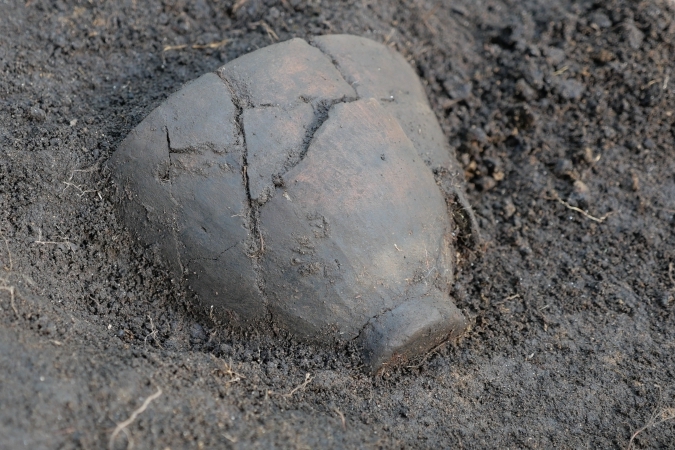
A Satsumon culture pot, estimated to be from the 11th or 12th century, is found during a recent dig at a Tokoro archaeological site.
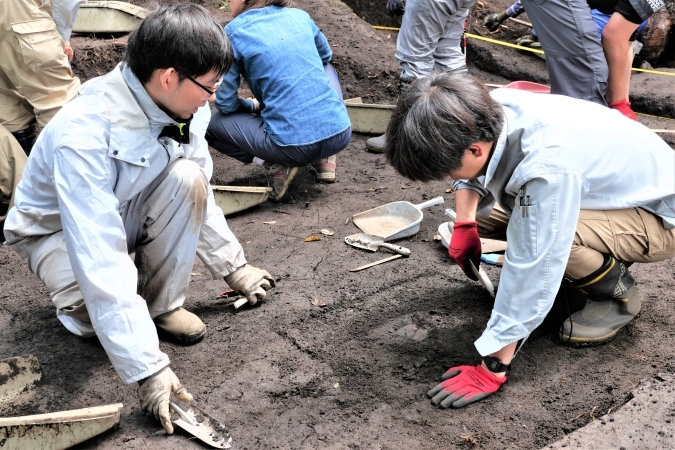
Students mark off an area for digging after a part of a pot is found.
That is how the second piece of Satsumon-Period earthenware was discovered from pit dwelling No. 5 at the archaeological site Oshima 2, which sits atop a hill overlooking the Sea of Okhotsk. (The survey of the No. 5 dwelling started in 2016.)
Every year from August till September, the Tokoro Research Laboratory, the sole off-campus facility affiliated with the Graduate School of Humanities and Sociology, hosts a monthlong archaeological fieldwork program for students, where they learn hands-on excavation skills while contributing to UTokyo’s research. The archaeological digs have taken place every summer since UTokyo researchers started excavations in Tokoro in 1957. A total of over 1,000 researchers and students have participated in the excavations so far.
Researchers say that, compared to mainland Japan, where archaeological research dates back to the pre-World War II period and a lot of academic insight has already been gained, northeastern Hokkaido, including Tokoro, still has many unresolved mysteries, making the region attractive to researchers interested in exploring Japan’s less-familiar history.That is why Tokoro holds special value for not only the Department of Archaeology but also archaeological research in Japan.
Tokoro-UTokyo ties
But why did UTokyo establish its archaeological lab in Tokoro, a town of 3,700 people, in the first place?
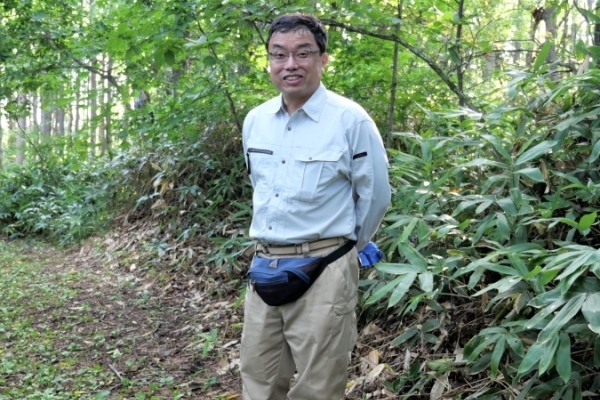
Professor Toshiaki Kumaki poses in a forest where ruins of Satsumon-Period pit dwellings are.
According to Kumaki — who has lived in Tokoro ever since he was posted there as a research associate over 20 years ago — prior to World War II (1939-1945), archaeological studies in the Faculty of Letters began as part of research on East Asian history, so the research sites were mostly in China and on the Korean Peninsula. Soon after the war, researchers led by Kazuchika Komai, then-assistant professor at the faculty, set up the Department of Archaeology.
Turning his attention to domestic ruins, Komai started archaeological work on the Moyoro Shell Mound in the city of Abashiri, on Hokkaido’s northern coast.
The Moroyo site has yielded many items from the Okhotsk culture, which existed between the 5th and 9th centuries only in the seaside areas of Hokkaido facing the Sea of Okhotsk.
UTokyo’s encounter with Tokoro, about an hour’s drive from Abashiri, started in 1955, when Shiro Hattori, a linguistics professor from the faculty, met a woman named Haru Fujiyama, one of the very few remaining speakers of the Sakhalin Ainu language, in Tokoro by chance. There, Hattori was approached by Nobutake Onishi, a local man engaged in the construction business.
“Mr. Onishi knew very well through his work in construction that Tokoro was rich in archaeological assets,” Kumaki said. “He had asked the Hokkaido Prefectural Government and other parties to investigate and protect the heritage, but he wasn’t taken very seriously. When he heard that a UTokyo researcher was visiting Tokoro, he barged in and made an impassioned pitch to Professor Hattori. The professor was moved by his passion and contacted Professor Komai at Hongo, the university’s main campus where the faculty is based. Komai became interested, and started surveying Tokoro ruins in 1957. The excavation work has continued to this day.”
In 1965, the town of Tokoro opened a museum to showcase the assets unearthed by UTokyo. That led to the opening two years later of the Tokoro Research Laboratory, with one assistant professor assigned there. The lab, whose establishment had been eagerly awaited by the local community, has been there ever since.
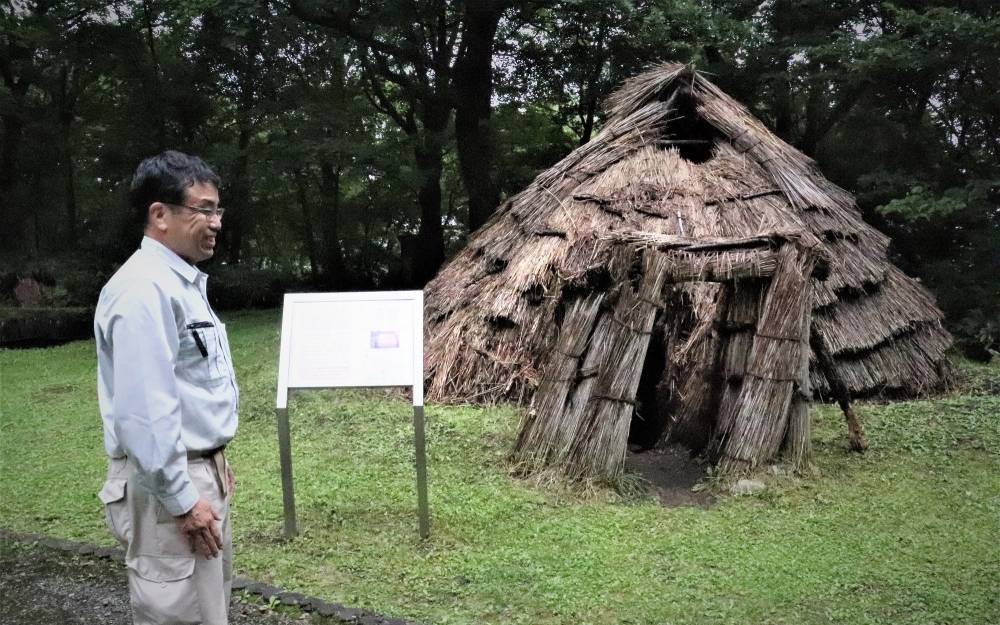
A walking trail has been created in the Tokoro Forest Park of Archaeological Sites, an area that includes the UTokyo laboratory, museums and restored pit dwellings with thatched roofs from the Jomon, Epi-Jomon (Post-Jomon) and Satsumon periods.
“Another history”
In many Japanese history classes, students learn that Japan moved from the Jomon Period (14,000-13,000 B.C. to 400 B.C.), whose people lived off foraging and hunting, to the Yayoi Period (400 B.C. to about A.D. 600), when farming began.
But in Hokkaido, farming didn’t start until much later, and for centuries the history there was quite different from that on the mainland.
In Hokkaido, following the Jomon Period, characterized by the rope patterns pressed into the clay of its pottery, the Epi-Jomon (Post-Jomon) Period lasted about 1,000 years, from around 400 B.C. until the 7th century. In the Epi-Jomon Period, which existed only in Hokkaido, people continued to forage for nuts and hunt animals for food.
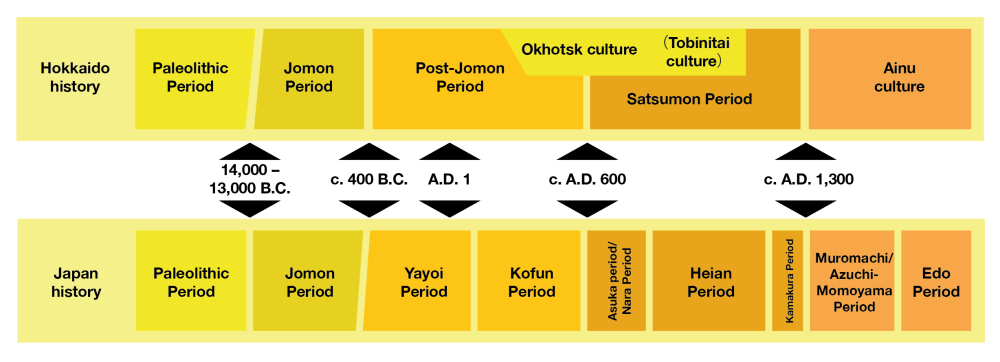
Archaeological periods in Hokkaido and other regions
After that came the Satsumon Period of the 7th-13th centuries, during which people continued to live in houses constructed in semiunderground pits, consisting of walls and thatched roofs. The Satsumon culture evolved into the Ainu culture around the 14th century. Meanwhile, between the 5th and 9th centuries, migrants from the north settled on lands close to the Sea of Okhotsk, forming a completely different culture. People in the Okhotsk culture mainly fished and hunted sea animals for food and worshipped bears.
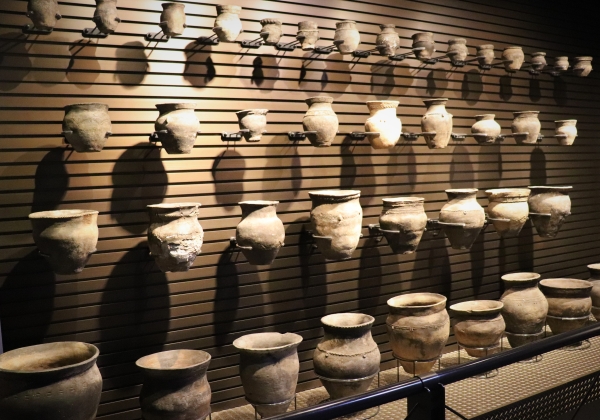
Pots from the Okhotsk culture are on display at the Hokkaido Museum of Northern Peoples in Abashiri, Hokkaido.
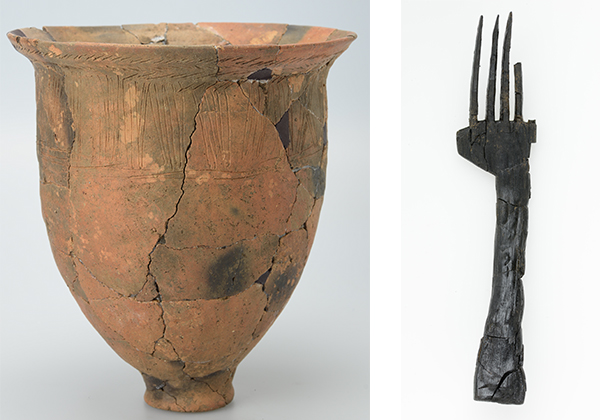
Left: Pottery from the Satsumon Period, excavated from pit dwelling No. 2 at the archaeological site Oshima 2 in Tokoro, Hokkaido. The pots’ surfaces feature scraping patterns made by spatulas.
Right: A carbonized wooden fork from the Satsumon Period excavated by Kumaki’s team.
Kumaki says Tokoro is unique among many historical sites in Hokkaido in that people lived there continuously, spanning a wide range of time periods and cultures — from Paleolithic, Jomon and Epi-Jomon to Satsumon and Okhotsk — and that numerous remains from these periods are left intact.
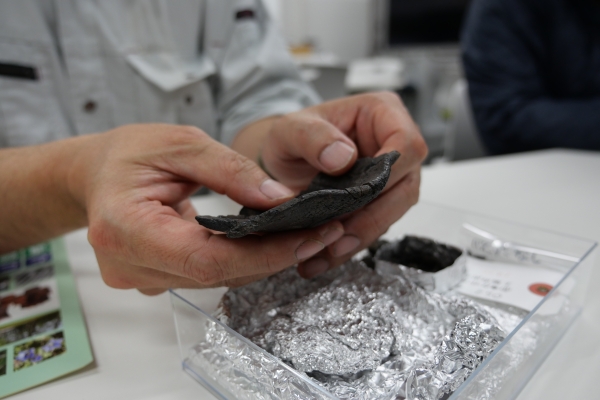
A carbonized piece of what is believed to be a wooden ladle
Tokoro, where over 3,000 ruins of pit dwellings remain (as detected by depressions in the surface of the land), is thus a fascinating place for early-Japan history buffs. But since the time and resources for archaeological surveys are limited, researchers need to select and focus on ones that are academically valuable.
Kumaki himself has been interested in the relationship between the Satsumon and Okhotsk cultures. The pottery and carbonized materials excavated from the dwellings, such as parts of roofs and pillars, provide crucial clues on the lives of early settlers.
“In this area we are blessed with rich research resources, especially when we consider their Russian Far East connections. Our job is coming up with hypotheses and testing them through our excavations. If our hypotheses are proven correct, that’s exciting, but even when they are proven wrong, that’s interesting, too. Every time we dig, we find something new. We keep revising the hypotheses based on our findings and keep repeating that cycle.”
For example, in the Satsumon culture, many residences were incinerated. In the Oshima sites, all five pits excavated so far were confirmed as being burned.
“Why did people back then burn their houses? In Ainu culture, when somebody dies, those who are left behind burn the dead person’s house, or create a model of the house and burn it, so it can be sent to the kingdom of the gods and used by the deceased there, in a ritual called ie okuri (sending a house away). There’s a theory that Satsumon culture had similar customs, and we are beginning to learn through excavations that people in the Satsumon Period burned their houses as part of their rituals.”
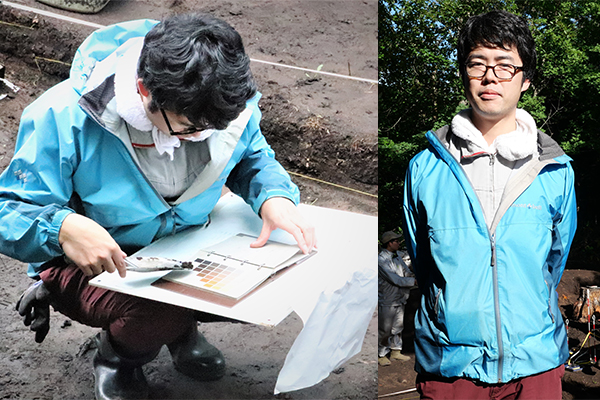
Left: Assistant Professor Daigo Natsuki (also pictured standing at right) checks a sample of mud against a color chart. Soil colors are important indicators of the time periods and features of the ruins.
Assistant Professor Daigo Natsuki, who is the only other faculty member at the Tokoro research lab, says he finds Hokkaido’s early history fascinating and wants to keep focusing his research on the area.
In June this year, Natsuki discovered pieces of what is believed to be a pot from the very early days of the Jomon Period at another site, the Tachikarushunai site in the town of Engaru. Engaru, west of Tokoro, is also along the Sea of Okhotsk coast.
The pot is believed to have been made 11,500-16,000 years ago, which is categorized as the Paleolithic Period or Old Stone Age. There is growing evidence that people from such early times migrated from mainland Japan to Hokkaido, forming the culture of the very early Jomon Period.
The early Jomon Period is characterized by what’s called Tsumegatamon (fingernail-patterned) pottery, featuring surfaced patterns that were created by fingernails or fingernail-like tools.
Such pottery had been discovered in the city of Obihiro in the eastern Hokkaido region of Tokachi, suggesting that mainlanders had come as far as Obihiro. But the June survey of the Tachikarushunai site yielded over 40 broken pieces of the pots, proving that people back then traveled further north, close to the extremely cold and dry Sea of Okhotsk. “Japan’s archaeological research is rich in history and a lot of insight has been accumulated,” Natsuki said. “So, the mainland has been fully explored and there’s a lot we already know archaeologically. But Hokkaido, which is removed from places where a lot of major events in Japanese history took place, still holds potential for interesting discoveries. Learning about the history of Hokkaido can then shine a spotlight on the history of the rest of the country. I find the history and the cultural traditions of Hokkaido truly fascinating.”
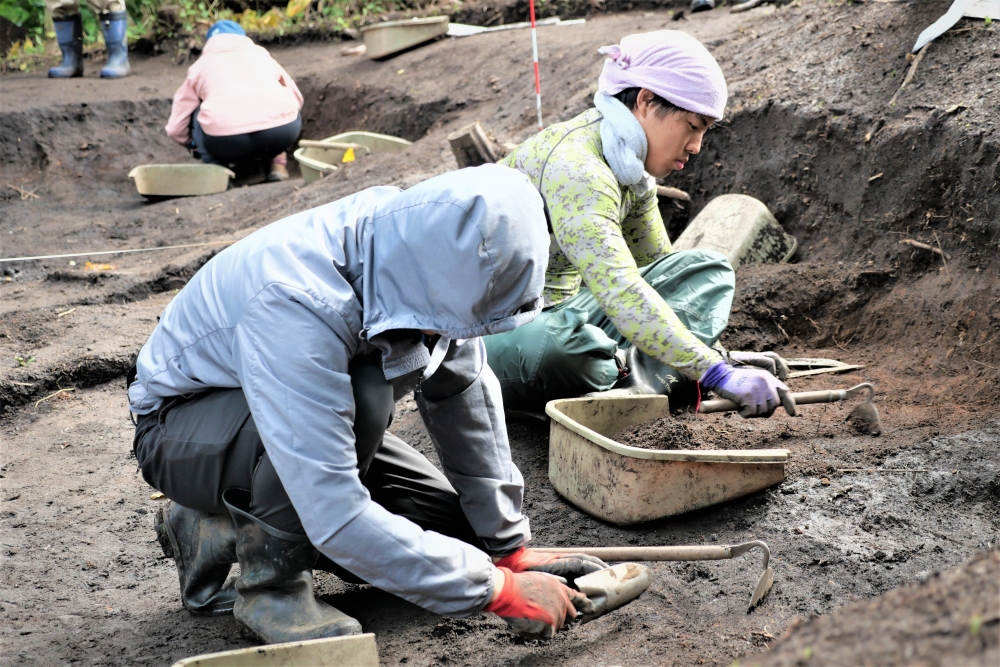
Students tackle a muddy and slippery site, which is also infested with mosquitoes.
A unique experience
The excavation training in Tokoro is one of the required classes for archaeology majors. Students spend a month together in a dormitory at the research facility, eating meals prepared three times a day during their stay by people from the local town. Supervised by teaching assistants, the participants immerse themselves in the world of archaeology from 8:30 a.m., when the morning meeting is called, until 8 p.m., when the evening meeting wraps up.
“I live alone, so this is my first communal-living experience with other students,” said Shinya Fukunaga, a third-year student. “I get up at 7:30 a.m. and we gather for the day’s meeting at 8:30 a.m. I admit I live very differently now compared to when I attend classes on the Hongo Campus. I’m getting used to (early mornings),” he said, laughing.
Fukunaga, a native of Hyogo Prefecture in western Japan who became interested in archaeology by visiting ancient tomb sites in Osaka and Nara prefectures closer to his hometown, says he wants to become an archaeologist in the future.
“I took entry-level classes in Hongo, but this is the first time I have participated in excavations. I didn’t even know the names of the tools at first. You can never experience firsthand what it’s like to discover pots and carbonized materials if you stayed in the classroom. I feel I’m extremely lucky, as a third-year undergraduate student, to have an opportunity like this.”
Nagisa Hashimoto, likewise a third-year student, says she wants to go to graduate school to further study archaeology, aiming to become a museum curator.
“I had thought I would come up with archaeological objects more easily. When we visited the site for the first time, the area was covered with weeds. Our first task was removing the weeds and the fallen leaves that had piled up at the site,” Hashimoto recalled.
“But it’s fun. When I stumble upon a piece of carbonized material and find that it is part of a burnt house roof, I think back to the days when people were actually using it. It’s amazing I can see a relic from the past that has survived all these years.”
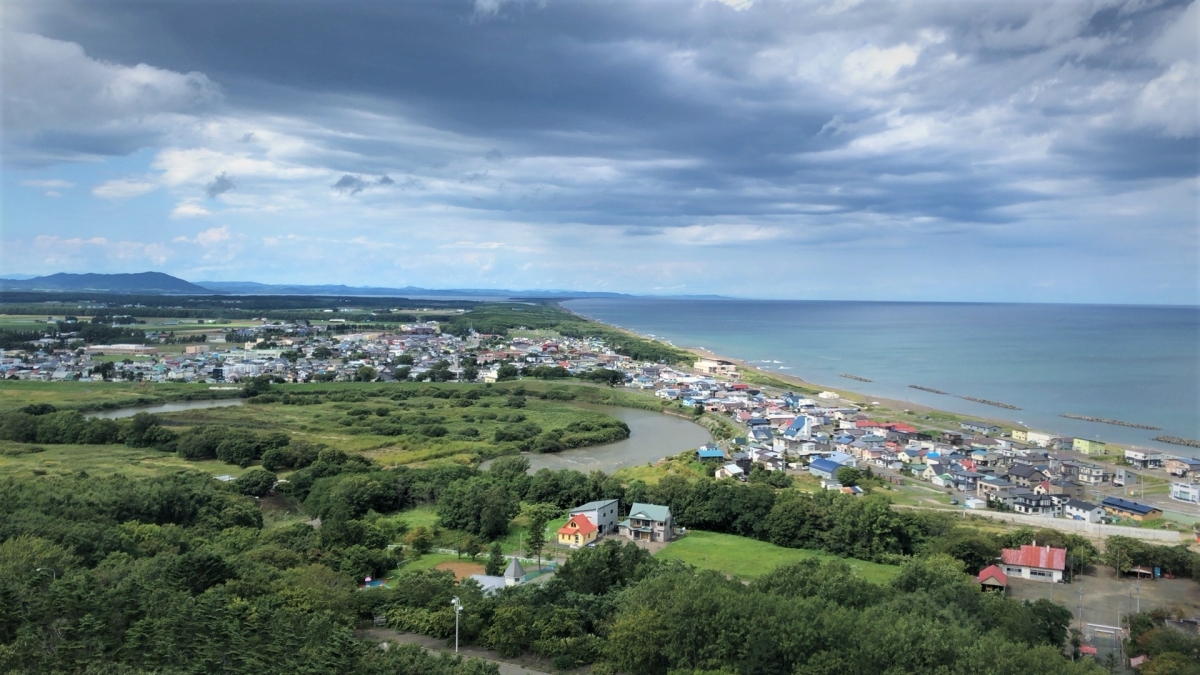
The town of Tokoro and the Sea of Okhotsk seen from an observation tower near the Oshima 2 site, where this year’s UTokyo’s excavation training was held.
Interview/Text: Tomoko Otake






